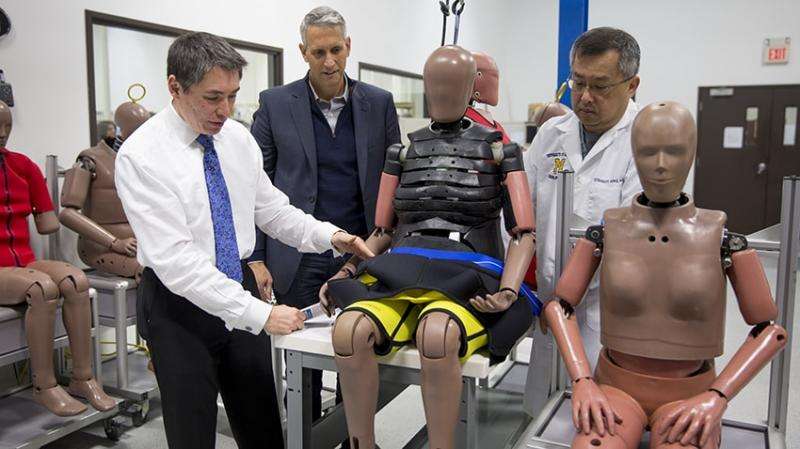Crash-test dummies move beyond young, thin and male

With input from U-M trauma experts, elderly and obese dummies are being used to help car manufacturers create safer vehicles for today's drivers. As the American population gets older and fatter, the crash-test dummies used to test the cars people drive are changing, too.
Recently, engineers at manufacturer Humanetics created dummies that reflect today's drivers: a 273-pound obese dummy that is 106 pounds heavier than the traditional model and a prototype for an elderly dummy based on a 70-year-old woman who is overweight, too.
The changes come years after Michigan Medicine trauma surgeon Stewart Wang, M.D., told car safety engineers that "crash-test dummies look nothing like my patients."
"You can't talk about injuries without talking about the person—it's individuals who are hurt," says Wang, who is a sought-after collaborator on car safety as the director of the U-M International Center for Automotive Medicine (ICAM).
"The condition, size and shape of an individual is hugely important in how severe their injuries are in any given crash."
A study from the University of California, Berkeley, published in 2013, found that obese drivers are up to 78 percent more likely to die in car crashes. Those who survive have unique injuries based on size.
For example, in frontal crashes, obese drivers tend to "submarine," or slide under the lap belt; their lower bodies are also poorly restrained because their lap belts have much more slack. As a result, they suffer more severe lower-extremity injuries at a much higher rate. Once they suffer such injuries, their obesity makes treatment more difficult and delays recovery.
"The typical patient today is overweight or obese—they're the rule rather than the exception," Wang says.
Developing dummies
Wang has seen firsthand the devastating and often fatal injuries that occur during car crashes, and he helps translate complex medical information into concepts that automotive engineers can use.
His research has helped bring automotive safety research and engineering into the modern era, with insights based on detailed analysis of live patients from real-world crashes rather than laboratory testing of cadavers.
Teams at ICAM gain tremendous insight from hundreds of thousands of CT scans, which can quickly be used for 3-D printing of prototypes once they're shared with engineers. This has revolutionized the way dummies are made—and what they look like.
The obese dummy has a body mass index of 35. The Centers for Disease Control and Prevention considers anyone with a BMI of 30 or higher obese.
The new elderly dummy has a BMI of 29, and its torso and chest have been substantially redesigned, sagging a bit more than the military physique of the crash-test dummies safety testing usually relies on.
As the structure of the chest changes from the 20s to the 80s, the risk of chest injury goes up fifteenfold, Wang says.
"Few would have envisioned that people would drive into their 80s, but we have to look at that," says Chris O'Connor, president and chief executive officer at Humanetics, which is based in Plymouth, Michigan. "As the population changes, we must have test equipment that resembles consumers today."
Car safety down the road
The future of car safety may include adaptive restraint systems that allow coordination of seat-belt tension, power of the airbag, and when and how much the airbag inflates.
"There's no new single safety device that will markedly improve driver safety," says Wang, but he's interested in seeing how well recently introduced center airbags work in the real world. These airbags inflate between the front seats to prevent passengers and drivers from striking each other in side-impact crashes.
Both experts are hopeful that autonomous vehicles can mitigate crashes through automatic breaking systems and other features. But over the next 30 to 40 years, there will still be a mix of traditional and autonomous vehicles, and injurious crashes will occur regularly, they say.
To date, the Asian and European markets have largely driven pedestrian safety concerns because those regions have smaller roads and more walkers. But pedestrian deaths are rising in the United States.
One-fourth of road deaths in the Ann Arbor community where Wang works involve pedestrians. The future design of vehicles may include modifications that keep pedestrians from being pinned under a vehicle.
"Our drive is the same as automakers': If fatalities get down to zero, that's our goal," says O'Connor. "So 35,000 vehicle fatalities in the U.S. is not acceptable to any of us. It's important for us to create a product that can be used to design safer cars."


















